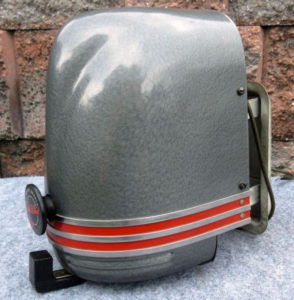SOUTH WIND
A century ago, comforts available in our homes had not migrated to the automobile. Many comforts, having been developed for the automobile, were only available as add-ons the owner could install or might have installed by a mechanic.
Stewart-Warner, known for making speedometers and odometers, made another device that received widespread acclaim and remained in use into the late 20th century. What was this non-speedometer item produced by Stewart-Warner that found such widespread demand? Hint: this article’s title is a clue!
Answer
A century ago a small finned coil was placed inside the passenger compartment of a motor vehicle, often under the front seat, and hot engine coolant was circulated through the coil while air from a fan blew across the coil to attempt to make passengers more comfortable. The engines of that era were lower horsepower and less efficient thus the water was not that warm when it finally did rise to a temperature that would warm a vehicle’s interior It took time for those engines to warm to operating temperatures and required the engine to be working vs idling to produce sufficient heat to warm a passenger compartment. Into the 1950s car models with coolant heaters were often an option as many standard models came without a heater. Add in that recorded temperatures a century ago were generally 5° Fahrenheit less than average annual temperatures in North America today and heaters a century ago were not only way less efficient, they were required to work harder than those of today.
 Harry J. McCollum addressed the automobile passenger compartment heating issue with a gasoline fired heater of his own invention. Gasoline heaters had a problem with stable combustion at the time and McCollum was able to come up with a design that used a car’s manifold vacuum to stabilize combustion. Additionally, the heater could heat up a vehicle’s passenger compartment in little more than a minute to short-sleeve warmth which greatly reduced the time to melt snow and ice from windshields. Henry J. De N. McCollum named his device the South Wind Heater and applied for a patent (received patent 2,191,173 in 1936).
Harry J. McCollum addressed the automobile passenger compartment heating issue with a gasoline fired heater of his own invention. Gasoline heaters had a problem with stable combustion at the time and McCollum was able to come up with a design that used a car’s manifold vacuum to stabilize combustion. Additionally, the heater could heat up a vehicle’s passenger compartment in little more than a minute to short-sleeve warmth which greatly reduced the time to melt snow and ice from windshields. Henry J. De N. McCollum named his device the South Wind Heater and applied for a patent (received patent 2,191,173 in 1936).
McCollum’s next problem to solve related to manufacture and marketing of his device as he believed there was a market for such a device. As McCollum was from Evanston, IL and Stewart-Warner had a plant in Chicago, he visited the plant and sought out the company’s chief engineer, Arden LeFevre. Soon LeFevre had his staff pouring over McCollum’s drawings and the example he had brought with him. After several hours of answering questions, McCollum could see he was not making progress so he invited the group to join him in his old Chrysler. Within ninety seconds the gentlemen were opening coats and removing hats because the car, which had cooled to windy city temperatures during their meeting, had become very cozy inside. McCollum made a note in his 1934 diary; “Today I demonstrated the heater to Stewart-Warner. It worked better than it ever had before and probably better than it ever will again.” McCollum soon signed a contract with Stewart-Warner to manufacture the product. By 1948 more than 3 million units had been installed. The heaters became known as “driving with a fireplace in your car.”
Our story does not end here. The heater’s design was expanded to heat school buses, motor homes, ambulances, and trucks. There were numerous military versions that found use in tanks, ground vehicles, and even airplanes. Air-cooled Volkswagens of the 1970s relied on McCollum’s heater design. McCollum would obtain over 50 patents related to the heating of cars, trucks, airplanes, and other transportation vehicles. The video link below discusses the South Wind Heater installed on a 1941 Plymouth.
